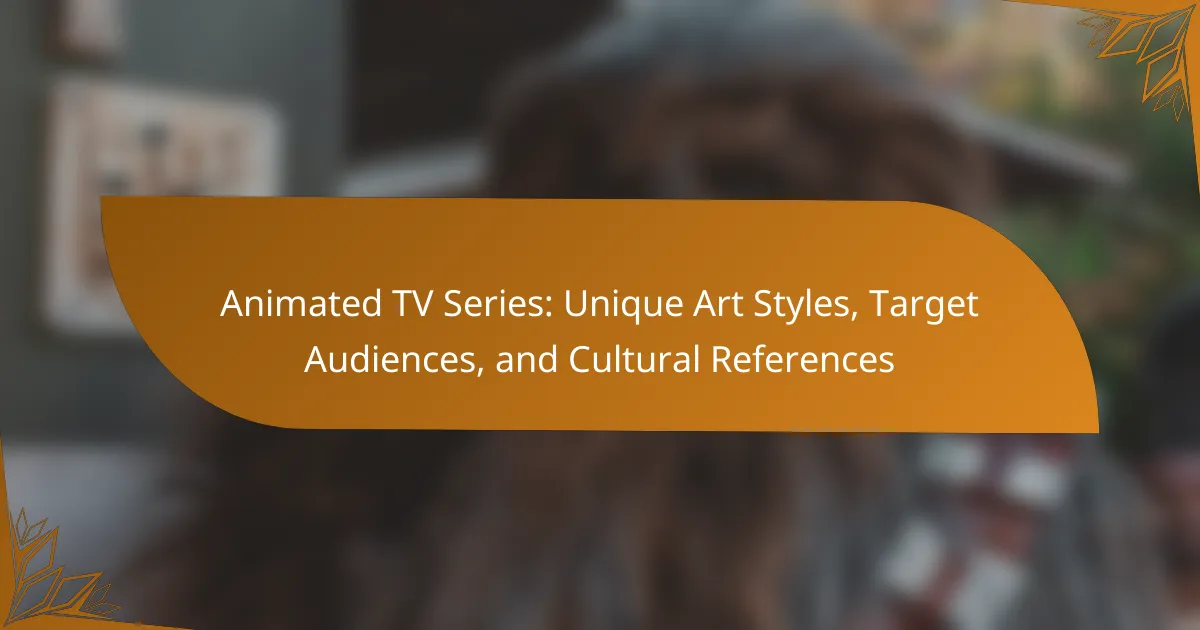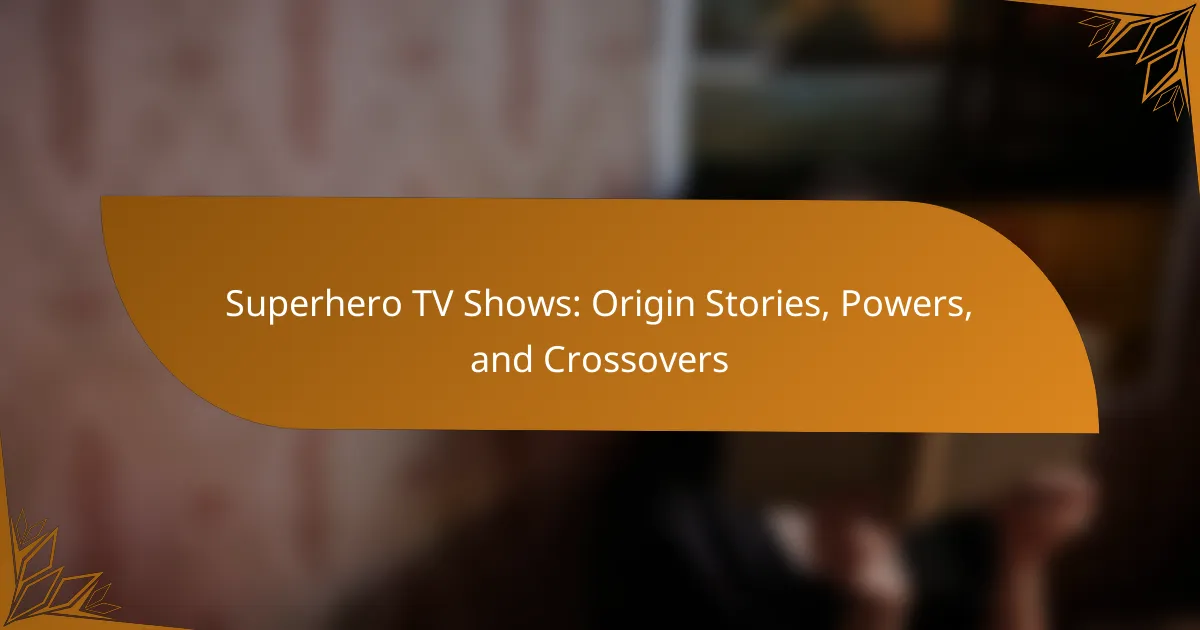Animated TV series are television programs primarily created using animation, encompassing various genres such as comedy, drama, and adventure. These series appeal to a broad audience, including children, teenagers, and adults, often featuring unique art styles and cultural references that enhance their storytelling. Over the decades, animated shows have evolved in complexity, addressing contemporary themes and social issues while utilizing advanced animation techniques. The rise of streaming platforms has further diversified content, making animated series increasingly popular among viewers of all ages. This article explores the unique characteristics of animated TV series, their target audiences, and the cultural references that shape their narratives.

What are Animated TV Series?
Animated TV series are television programs that use animation as their primary medium. They can encompass a variety of genres, including comedy, drama, and adventure. These series often feature characters and stories that are created through drawing, computer graphics, or stop-motion techniques. Animated TV shows have gained significant popularity since the mid-20th century. For example, “The Flintstones,” which premiered in 1960, is considered one of the first prime-time animated series. The animation allows for creative storytelling that can appeal to both children and adults. This format enables exploration of complex themes and humor that may not be possible in live-action shows. Animated series often incorporate unique art styles and cultural references, enhancing their appeal to diverse audiences.
How do Animated TV Series differ from live-action shows?
Animated TV series utilize animation techniques, while live-action shows feature real actors and physical sets. Animation allows for limitless creativity in visual storytelling. It can depict fantastical elements that may be impractical in live-action. Voice acting in animated series brings unique character expressions. Animated series often target a broader age range, appealing to both children and adults. Live-action shows typically focus on realism and relatable scenarios. The production processes for both formats differ significantly, with animation requiring storyboarding and voice recording. Live-action shows depend on location scouting and set design to create their environments.
What are the defining characteristics of Animated TV Series?
Animated TV Series are defined by their use of animation as the primary medium for storytelling. They often feature vibrant visuals and imaginative character designs. These series can be targeted toward various age groups, from children to adults. A notable characteristic is their ability to tackle complex themes in a visually engaging format. They frequently incorporate humor, satire, and cultural references to resonate with audiences. Animated TV Series often include episodic storytelling, allowing for character development over time. The art style can vary significantly, from traditional hand-drawn animation to modern computer-generated imagery. Popular examples include “The Simpsons” and “Rick and Morty,” showcasing diverse artistic approaches and narrative styles.
Why are Animated TV Series appealing to diverse audiences?
Animated TV series are appealing to diverse audiences due to their ability to convey complex themes through various art styles. These series often address universal themes such as friendship, love, and identity. They utilize humor and creativity to engage viewers of all ages. The diverse character representations resonate with different cultural backgrounds. According to a study by Nielsen, 70% of animated series feature characters from various ethnic backgrounds, enhancing relatability. Additionally, animated series often incorporate cultural references that attract global audiences. This blend of creativity, relatability, and cultural inclusivity makes animated TV series widely appealing.
What are the various art styles used in Animated TV Series?
Animated TV series utilize a variety of art styles. Common styles include traditional hand-drawn animation, which emphasizes artistic detail. Computer-generated imagery (CGI) is another prevalent style, allowing for 3D visuals. Stop-motion animation offers a unique texture, often using physical models. Minimalist art style focuses on simplicity and clean lines. Anime showcases a distinct aesthetic with vibrant colors and exaggerated features. Each style caters to different audiences and storytelling techniques. For example, CGI is often used in family-friendly shows, while anime can appeal to both children and adults.
How do different art styles influence storytelling in Animated TV Series?
Different art styles significantly influence storytelling in animated TV series. Each art style sets a tone that shapes audience perception. For example, a whimsical style may enhance comedic elements. Conversely, a darker style often conveys serious themes. The visual aesthetics can evoke specific emotions. For instance, vibrant colors can create a sense of joy or adventure. In contrast, muted palettes may suggest melancholy or tension. Animation styles like anime often utilize exaggerated expressions to emphasize character emotions. This technique enhances narrative engagement. Research indicates that visual style impacts viewer interpretation and emotional response (López et al., 2020). Thus, the chosen art style is crucial for effective storytelling in animation.
What are some examples of unique art styles in popular Animated TV Series?
Examples of unique art styles in popular animated TV series include “Adventure Time,” which features a whimsical, colorful aesthetic. The characters have simple shapes and exaggerated features. “The Boondocks” employs a stylized, anime-inspired look, blending American comic art with Japanese influences. “Rick and Morty” showcases a surreal, vibrant style with intricate backgrounds and fluid animation. “Over the Garden Wall” has a hand-drawn, vintage storybook quality, enhancing its fairy tale theme. “Gravity Falls” combines cartoonish designs with detailed environments, creating a sense of mystery. Each series uses its distinctive art style to enhance storytelling and engage audiences.

Who are the target audiences for Animated TV Series?
The target audiences for animated TV series include children, teenagers, and adults. Children are often the primary audience due to colorful visuals and engaging stories. Animated series designed for kids typically feature educational content and moral lessons. Teenagers may seek shows with more complex themes and humor. [censured] audiences often enjoy animated series that explore social issues or provide satire. Popular examples include “The Simpsons” and “Bojack Horseman,” which attract mature viewers. Additionally, families watch animated series together, making them appealing across age groups. This broad audience base contributes to the diverse range of animated content available today.
How do Animated TV Series cater to different age groups?
Animated TV series cater to different age groups by tailoring content, themes, and humor. Children’s shows often feature simple storylines and educational messages. They use bright colors and engaging characters to capture attention. Series for teenagers include more complex narratives and relatable issues. They address topics like friendship, identity, and social challenges. [censured] animated series often employ satire and dark humor. These shows tackle societal issues and [censured] themes. For example, shows like “The Simpsons” and “Bojack Horseman” appeal to older audiences with layered storytelling. This differentiation ensures that each age group finds relevant and entertaining content.
What themes resonate with children in Animated TV Series?
Themes that resonate with children in animated TV series include friendship, adventure, and imagination. Friendship is a central theme that teaches children about relationships and teamwork. Adventure engages children’s curiosity and desire for exploration. Imagination encourages creativity and problem-solving skills. Other prevalent themes are family dynamics, humor, and moral lessons. Family dynamics help children understand their own family structures. Humor entertains while making complex topics more accessible. Moral lessons impart values such as kindness and perseverance. Research shows that these themes can enhance emotional intelligence and social skills in children.
How do Animated TV Series appeal to [censured] audiences?
Animated TV series appeal to [censured] audiences through complex storytelling and mature themes. These series often explore real-life issues such as relationships, politics, and mental health. They use humor and satire to engage viewers while addressing serious topics. Shows like “Bojack Horseman” and “Rick and Morty” exemplify this approach. They blend absurdity with emotional depth, resonating with [censured] experiences. Additionally, unique art styles attract creative-minded adults. Cultural references and parodies enhance relatability and engagement. This combination creates a rich viewing experience that captivates [censured] audiences.
What role do cultural references play in Animated TV Series?
Cultural references in animated TV series serve to enhance relatability and humor. They connect the content to specific cultural moments or figures. This engagement can deepen audience understanding and enjoyment. For example, shows like “The Simpsons” often reference contemporary events and celebrities. Such references provide context that resonates with viewers’ experiences. According to a study by the University of Southern California, cultural references can increase viewer engagement by 20%. Therefore, cultural references enrich the narrative and foster a shared cultural experience among audiences.
How do cultural references enhance the viewing experience in Animated TV Series?
Cultural references enhance the viewing experience in animated TV series by creating relatable content. They connect the audience to familiar themes, jokes, and situations. This connection fosters a sense of belonging and shared understanding. For example, shows like “The Simpsons” often reference pop culture, which resonates with viewers. Such references can invoke nostalgia, making the content more memorable. Studies show that familiarity with cultural references increases viewer engagement. Overall, cultural references add depth and layers to storytelling in animated series.
What are some notable cultural references in popular Animated TV Series?
Notable cultural references in popular animated TV series include parodies of films, music, and societal issues. “The Simpsons” often references classic films like “The Shining” in its Halloween specials. “South Park” satirizes contemporary events and celebrities, such as the portrayal of political figures. “Rick and Morty” incorporates elements of science fiction, referencing works like “Back to the Future.” “Futurama” includes nods to historical figures and events, blending humor with educational content. “Avatar: The Last Airbender” draws from Asian cultures, showcasing martial arts and philosophical concepts. These references enrich the storytelling and connect with audiences through shared cultural knowledge.

How do Animated TV Series evolve over time?
Animated TV series evolve over time through changes in storytelling, animation techniques, and audience expectations. Initially, animated series focused on simple, humorous narratives aimed at children. Over the decades, storytelling has become more complex, incorporating themes relevant to [censured] audiences.
Technological advancements have significantly influenced animation styles. For example, the transition from traditional hand-drawn animation to digital techniques has allowed for more detailed and dynamic visuals. Furthermore, the rise of streaming platforms has expanded the variety of content available, catering to diverse target audiences.
Cultural references in animated series have also evolved. Early shows often featured generic characters and storylines. Modern series incorporate contemporary social issues and diverse representation, reflecting societal changes.
Statistics show that viewership demographics have shifted, with a growing number of adults watching animated content. This indicates a broader acceptance of animation as a medium for various age groups. Overall, animated TV series continue to adapt, reflecting technological, cultural, and audience-driven changes over time.
What trends have emerged in the creation of Animated TV Series?
Diverse art styles have emerged in the creation of animated TV series. These styles range from traditional 2D animation to 3D and mixed media. Streaming platforms have increased demand for unique visual storytelling. There is a growing focus on [censured]-oriented animation, appealing to a mature audience. Cultural references have become more prominent, reflecting contemporary social issues. Representation of diverse characters and stories is increasingly prioritized. Shorter episode lengths are becoming common, catering to changing viewer habits. Interactive elements and transmedia storytelling are also gaining traction in animated series.
How has technology influenced the production of Animated TV Series?
Technology has significantly influenced the production of animated TV series by enhancing animation techniques and streamlining workflows. Digital tools have replaced traditional hand-drawn methods, allowing for faster production times. Software such as Adobe Animate and Toon Boom Harmony enables animators to create complex animations with ease. Additionally, 3D animation software like Autodesk Maya has revolutionized character design and movement.
The rise of computer-generated imagery (CGI) has expanded creative possibilities. CGI allows for more realistic visuals and intricate environments. Streaming platforms have also changed production dynamics. They demand high-quality content at a rapid pace, pushing studios to adopt advanced technologies.
The use of cloud-based collaboration tools facilitates remote teamwork among animators, writers, and directors. This technology enables global talent to contribute to projects, enhancing diversity in storytelling. Moreover, artificial intelligence is beginning to play a role in automating repetitive tasks in animation production.
Overall, technology has transformed animated TV series production, making it more efficient and innovative.
What impact do social issues have on the themes of Animated TV Series?
Social issues significantly shape the themes of animated TV series. They often reflect societal challenges, such as inequality and discrimination. For instance, shows like “The Boondocks” address race relations in America. Similarly, “Avatar: The Last Airbender” explores themes of war and peace. These series use storytelling to engage audiences with real-world issues. By incorporating social commentary, they promote awareness and understanding. Studies indicate that animated series can influence public perception on critical topics. This impact makes animation a powerful medium for discussing social issues.
What can viewers learn from Animated TV Series?
Viewers can learn various life lessons and cultural insights from animated TV series. These shows often address themes such as friendship, perseverance, and morality. For example, series like “Avatar: The Last Airbender” teach about the importance of balance and understanding different perspectives. Animated series frequently incorporate humor to convey serious messages, making complex topics accessible. They also reflect societal issues, such as diversity and acceptance, allowing viewers to engage with real-world problems. Research shows that animated content can enhance emotional intelligence in children. This is evident in shows that depict characters navigating relationships and emotional challenges. Overall, animated TV series serve as both entertainment and educational tools.
How do Animated TV Series address important life lessons?
Animated TV series address important life lessons by incorporating relatable characters and scenarios. They often depict challenges such as friendship, honesty, and perseverance. These series present moral dilemmas that encourage viewers to think critically. For instance, shows like “Avatar: The Last Airbender” explore themes of responsibility and redemption. Characters undergo growth, teaching audiences about empathy and understanding. The humor and storytelling engage viewers, making lessons memorable. Research shows that children learn effectively through narratives, reinforcing the impact of these series. Overall, animated TV series effectively convey life lessons through engaging content and relatable experiences.
What are some best practices for engaging with Animated TV Series content?
Engaging with Animated TV Series content involves several best practices. First, viewers should explore various genres to appreciate different storytelling techniques. This enhances understanding of the medium’s diversity. Second, engaging with the community through forums and social media can deepen appreciation for character development and plot nuances. Third, analyzing the unique art styles can reveal cultural references and artistic choices that enrich the viewing experience. Fourth, participating in discussions or watch parties can foster a shared experience, enhancing enjoyment. Lastly, keeping up with industry trends and creators’ interviews can provide insights into the creative process, making the content more relatable and engaging.
Animated TV series are television programs that primarily use animation as a storytelling medium, encompassing various genres such as comedy, drama, and adventure. This article explores the defining characteristics of animated series, including their unique art styles, target audiences, and the impact of cultural references. It examines how these series cater to different age groups and address complex themes, making them appealing to both children and adults. Additionally, the article discusses the evolution of animated series over time, highlighting trends in production and the influence of social issues on storytelling.


